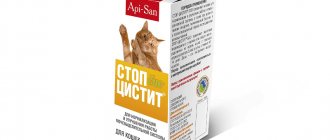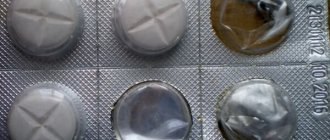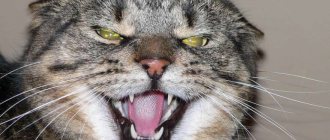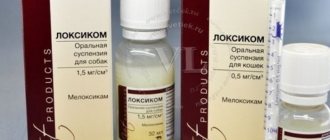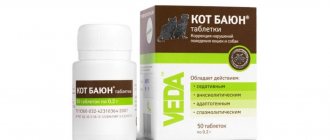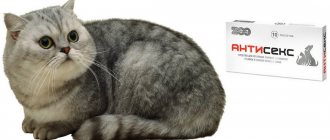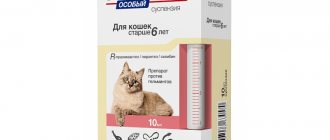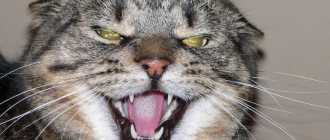Save the article:
The domestic drug Dirofen is one of the most effective in the line of anthelmintic drugs for pets. Dirofen for cats is produced by Api-San LLC. The instructions for use compiled by the manufacturer contain a detailed description of the composition, treatment regimen, contraindications and side effects. If necessary, the product can be replaced with drugs with similar components.
Release form and composition
Dirofen for cats is offered for oral use in three forms: suspension, paste, tablets. When choosing, it is necessary to base your pet’s preferences, its age, and also take into account the convenience of feeding the drug.
The drug in any form is stored at a positive temperature (from 0 to 25 degrees) away from direct sunlight
Dirofen suspension
global $ads_google; //data-ad-slot=”2475549904″ $ads_google = empty($ads_google) ? false : true; ?> if ($ads_google == false) {?>
$ads_google = true; ?> } ?>
The liquid form of the medicine is a yellowish solution with a viscous, thick consistency. The suspension is bottled in plastic bottles of 6 or 7 ml. The package includes a syringe for dosing the drug.
The anthelmintic effect of the suspension is due to two active compounds: praziquantel and pyrantel pamoate. Auxiliary components include food additives (E211, E951, E952), carboxymethylcellulose, pumpkin seed oil. The last ingredient improves the functioning of the gastrointestinal tract, restores the mucous membrane and supplies the cat’s body with useful substances.
Pills
The solid form of the drug is available in the form of round, light yellow tablets. On one side there are perpendicular marks that make it easier to divide the tablet into two or four parts. The “AS” logo is embossed on the other side. Capsules are packaged in cell paper bags (2, 3, 4, 6 pieces) or in plastic jars (3, 6, 10, 20 pieces).
The weight of one tablet is 200 mg (for adult cats) or 120 mg (for kittens). The activity of the drug against worms is due to a combination of three substances: febantel, praziquantel, pyrantel pamoate. The homogeneous fraction of Dirofen tablet powder is supplemented with lactose, food additive E572, talc, microcrystalline cellulose.
Dirofen paste
The medicine in appearance is a pasty mass of a light yellow hue. The drug is packaged in polymer syringes of 6 ml and 7 ml. This form is convenient because the syringe helps to dose the product, determining the required amount in milligrams. The active compounds in the paste are the same as in the suspension: praziquantel and pyrantel. As supporting components, the paste contains pumpkin oil, as well as cyclomate saccharin, aspartame, and carboxymethylcellulose.
pharmachologic effect
After oral administration, absorption occurs in the stomach and intestines. Once in the systemic bloodstream, the active substances reach the vessels of the intestinal wall and penetrate the body of helminths.
The therapeutic effect is due to a combination of three main components:
- febantel (a group of probenzimidazoles) – destroys roundworms. The substance is absorbed only in the intestine, and then is broken down into fenbendazole and oxfendazole, which have the greatest activity against nematodes. The action is based on two processes. The first is the suppression of the production of helminths necessary for nutrition (glucose consumption). The second is a slowdown in the production of proteins necessary for the functioning of parasite cells, which provokes the death of the helminth. Febantel is processed in the liver and excreted through the kidneys and intestines;
- pyrantel pamoate (pyrimidine group) – fights roundworms, including in the early stages of development (eggs and larvae). The mechanism of operation is to disrupt the polarization of muscle cells - this leads to the inability to transmit neuroimpulses, paralysis and death of the parasite. Pyrantel does not penetrate into tissues and is slowly absorbed in the intestinal lining, causing a long-term anthelmintic effect. 93% of the compound is excreted unchanged from the body during bowel movements;
- praziquantel (a group of pyrazinisoquinolines) – has anticestodal activity, destroys eggs, larvae and adult flat helminths. The main mechanism of action is to increase the permeability of cell membranes to calcium ions, causing a persistent disruption of polarization. This leads to disruption of nerve conduction, general muscle spasm, and then to paralysis and death of the endoparasite. The substance also causes degeneration of the tegument (skin-like layer) of the worm, facilitating the destruction and removal of helminths from the intestines. Praziquantel is partially processed in the liver, 80% of the component is excreted through the kidneys in the first 24 hours after administration.
If the recommended doses are observed, the drug:
- does not have a toxic effect on the fetus;
- does not provoke embryonic development disorders;
- does not increase the body's sensitivity to allergens;
- well tolerated by pets, regardless of age and breed.
Dosages
The amount of medicine that is considered sufficient to kill all the worms in the pet’s body is calculated by the weight of the animal. It is not recommended to exceed the indicated dose to avoid undesirable consequences. The dosage is also affected by the form of the drug:
- Dirofen tablets prescribed for kittens are given at the rate of 1 piece per 1 kilogram of weight.
- Tablets for adult cats are calculated from the proportion “one piece - 5 kg of weight”.
- The suspension is fed in an amount of 1 ml per 1 kg of animal body weight.
- The deworming paste has the same dosage as the liquid solution: 1 mg/1kg.
Precautionary measures
Dirofen can be used for 3 years after production. After this period, the tablets become unsuitable for use.
Store the medication in a dark place in a blister. The optimal temperature is 0–25°C.
The medicine must be hidden from children. It should not be stored next to food or animal feed.
When interacting with the drug, a person must follow these rules:
- do not consume drinks or food;
- no smoking;
- do not touch the mouth or mucous membranes;
- rinse your skin or eyes if the product comes into contact with the indicated areas;
- After completing the procedure, wash your hands with warm water and soap.
Important! Allergy sufferers are prohibited from contacting Dirofen tablets. If you suspect an allergy or accidentally swallowed the drug, you should consult a doctor, who should show the packaging or instructions.
Dirofen for cats must not be combined with drugs that contain piperazine (including anthelmintics). Its combination with cholinesterase inhibitor medications is undesirable. The latter are used to treat pathologies of the nervous system (inflammatory, degenerative).
How does it work on parasites?
Dirofen for worms is a combination medicine. It is the complex composition that causes a wide range of effects on parasites. The anthelmintic is effective against mature worms and their larvae. Both roundworms and tapeworms are vulnerable to the action of the drug.
global $ads_google; //data-ad-slot=”2475549904″ $ads_google = empty($ads_google) ? false : true; ?> if ($ads_google == false) {?>
$ads_google = true; ?> } ?>
Depending on the active substance, the mechanism of antiparasitic action differs. Praziquantel changes the degree of cell permeability in the body of the parasite and thereby increases the flow of calcium ions into the cells. This causes disruption of metabolism and water-salt metabolism. Pyrantel pamoate inhibits coenzymes involved in the transmission of nerve impulses to contractile fibers. The result of the combined action of poisons is paralysis of helminths and their death.
Febantel tablets complement the action of praziquantel and pamoate. This substance blocks one of the stages of helminth energy metabolism by disrupting the synthesis of necessary enzymes. As a result, the absorption of glucose in the body of the worms becomes impossible.
Indications for use
The drug is recommended for use in the treatment and prevention of helminthic infestations. The product fights a wide range of internal parasites:
- roundworms (nematodes) - toxocaras, toxascarids, hookworms, uncinaria, whipworms;
- flatworms (cestodes) - echinococcus, mesocystoids, bovine, pork and cucumber tapeworms, broad tapeworm.
Also components of the drug:
- effective against mixed helminthiases - the simultaneous presence of nematodes and cestodes;
- do not increase the resistance of intestinal parasites to treatment - therefore, it is not addictive;
- penetrate tissue structures, including the central nervous system;
- act on parasites at all stages of development - a single dose is sufficient for prevention.
Instructions for use of Dirofen
The anthelmintic is given to the animal at the first feeding in the morning, preferably on an empty stomach. Preliminary fasting or taking laxatives does not affect the result of treatment. The calculated dose of tablets is placed in food (a piece of meat, fish, cheese or minced meat). A convenient device for feeding capsules is an introducer (tablet dispenser). In some cases, the tablet is turned into a powder and diluted with a small amount of water. The suspension is drawn into a syringe and the contents are squeezed onto the root of the pet’s tongue. In the same way (from a syringe) the cat is given Dirofen paste and suspension.
The instructions indicate that preventive treatment against helminths with Dirofen must be carried out every three months. When treating cases of severe helminthic infestation, the drug is given twice with an interval of 10-12 days. Growing kittens are dewormed at 3, 6, 9, 12 weeks. Further, the scheme includes the 4th, 5th and 6th months. Then veterinarians advise following the instructions and giving the drug as prescribed - once every three months.
It is more convenient to combine routine deworming with vaccinations, since 10 days before vaccination the animal must be treated for worms
Reviews of the drug Dirofen for cats
Kira: “The yard cat gave birth and we decided to take the most charming kitten for ourselves. Already at home we noticed that his tummy seemed to be inflated. We purchased Dirofen at the veterinary pharmacy, which, according to the pharmacist, will act gently and confidently. I gave the pill at lunchtime, and by the evening a ball of worms came out. And then it started - lack of appetite, photophobia, even partial baldness! This went on for several days, and then the kitten returned to normal.”
Lydia: “We brought a cat from the dacha and before vaccinations, which we do once a year, I decided to drive away the worms just in case. We usually bought anthelmintic in the form of tablets, but here I decided to try the paste. I didn’t see any difference - a cat with foam spits everything out equally. But in the morning I saw a lot of “threads” in my stool. These were dead worms. For the first time I encountered them in reality and received such a range of emotions that I realized that I would be deworming regularly!”
Marat: “We took a Thai kitten and decided to do everything according to the rule - remove the parasites, get vaccinated. We stumbled already at the stage of removing parasites. They gave Dirofen at 8 a.m., at 12 p.m. the kitten began to thrash about, crawling with its butt on the floor, and then a piece of intertwined worms fell out of it. A disgusting sight!
Contraindications
According to the instructions for use, this anthelmintic is not suitable for all cats. The first limitation concerns age. For the first three weeks of a furry pet’s life, you should not feed it with praziquantel. If a kitten is infected with worms, Dirofen is replaced with another suitable drug.
The second exception relates to pregnancy. During the first half of the term, the use of the medicine in any form is not allowed. In the last months of gestation, anthelmintic medication is allowed to be fed after consultation with a veterinarian. Breastfeeding cats can be treated with an anthelmintic two weeks after giving birth with a doctor's approval.
The list of contraindications also includes a weakened or exhausted state due to serious illness (especially related to the kidneys or liver), infection, or surgery. The indication for changing the drug is individual intolerance to certain pharmaceutical components.
III. ORDER OF APPLICATION
8. Dirofen-paste 20 is prescribed to adult cats, puppies from 3 weeks of age, kittens from 3 weeks of age, ferrets and decorative rodents from 3-4 weeks of age, Dirofen-paste 60 - to adult dogs, for preventive and therapeutic purposes. nematodes (toxocarosis, toxascariasis, uncinariasis, trichuriasis, hookworm infection), cestodesosis (tenidosis, dipylidiasis, echinococcosis, diphyllobothriasis, mesocestoidosis) and mixed nematode-cestodiasis infestations.
9. A contraindication to the use of the drug is individual intolerance to the components of the drug (including a history of it). Dirofen paste 20 and 60 should not be used by debilitated animals, patients with infectious diseases or convalescent animals, females in the first half of pregnancy, puppies, kittens, rodents and ferrets under 3 weeks of age.
10. Dirofen paste 20 and 60 is administered to animals individually, once, in the morning feeding with a small amount of food, or injected forcibly onto the root of the tongue using a dispenser syringe in the following doses:
for adult dogs - 1 ml of Dirofen paste 60 per 3 kg of animal weight;
adult cats, puppies, kittens, ferrets and decorative rodents - 1 ml of Dirofen paste 20 per 1 kg of animal weight;
For pregnant bitches and cats, the drug is prescribed 3 weeks before the expected birth with caution, under the supervision of a veterinarian, for lactating females - 2-3 weeks after birth.
No preliminary fasting diet or use of laxatives is required.
In case of severe infestation, deworming is recommended to be repeated after 10 days.
For preventive purposes, deworming is carried out in a therapeutic dose once every 3 months, as well as before each vaccination.
11. With a significant overdose, the animal may experience a depressed state, refusal to feed, excessive salivation, and gastrointestinal disorders. In these cases, general measures are used aimed at removing the drug from the body.
12. No specific effects of the drug upon its first use and discontinuation have been identified.
13. The drug is intended for single use.
14. When using Dirofen paste 20 and 60 in accordance with these instructions, side effects and complications in animals, as a rule, are not observed. In case of increased individual sensitivity to the components of the drug and the appearance of allergic reactions, its use is stopped and the animal is prescribed antihistamines and symptomatic therapy.
15. Dirofen paste 20 and 60 should not be used simultaneously with piperazine and cholinesterase inhibitors.
16. Dirofen paste 20 and 60 is not intended for use in productive animals.
Side effects and overdose
The drug Dirofen is presented by the developer as safe from the point of view of mutagenic, carcinogenic, and toxic activity. According to the classification of harmful substances, it belongs to the moderately hazardous group. After taking the medicine, it is eliminated from the body within a day. Despite this characteristic, upon first and repeated use, the deworming drug with praziquantel and pyrantel can cause a number of unpleasant short-term consequences. They are associated with well-being, but do not affect overall health. Side effects include:
- salivation;
- nausea;
- vomit;
- loose stool;
- gas formation;
- loss of appetite;
- lethargy and apathy.
If an allergic reaction occurs in any form, it is recommended to show your pet to a veterinarian!
Contraindications and side effects
The drug Dirofen cannot be used in the following animals:
- females in the early stages of pregnancy;
- cats with hypersensitivity to the components of the drug;
- exhausted and weakened cats;
- animals suffering from infectious diseases and recovering.
If all conditions specified in the instructions are met, there are no side effects. In case of an overdose of an anthelmintic, the following symptoms are possible:
- depressed state;
- refusal of food;
- excessive salivation;
- gastrointestinal disorder (vomiting, diarrhea).
In such cases, you need to stop using the drug and also contact your veterinarian to prescribe symptomatic treatment. If a cat has an individual intolerance to the drug, then it may be prescribed antihistamines. Important: increased salivation is not always a sign of an overdose. Salivation intensifies when using Dirofen for the first time, there is no need to be afraid of this (it will go away spontaneously).
Average price for Dirofen for cats and kittens
The cost of packaging depends on the type of medicine and packaging.
- Dirofen tablets for adults and kittens in the amount of 6 pieces cost 120-130 rubles.
- Paste in a 7 ml syringe – 150-160 rubles. Paste packaging 10 ml - up to 180 rubles.
- The price of Dirofen suspension for cats with a volume of 7 ml falls within the range of 160-170 rubles, a slightly larger bottle (10 ml) costs on average 180-200 rubles.
- Suspension for kittens (6 ml) – from 150 to 170 rubles.
*Prices are indicated at the beginning of 2022.
global $ads_google; //data-ad-slot=”2475549904″ $ads_google = empty($ads_google) ? false : true; ?> if ($ads_google == false) {?>
$ads_google = true; ?> } ?>
I. GENERAL INFORMATION
1. Trade name of the drug: Dirofen-pasta 20 and 60 (Dirophen-pasta 20 and 60).
International nonproprietary names of active ingredients: pyrantel pamoate and praziquantel. 2. Dosage form: paste for oral use.
The drug is produced in two forms: Dirofen-paste 20 (for adult cats, kittens, puppies, ferrets and decorative rodents) and Dirofen-paste 60 (for adult dogs), containing 1 ml as active ingredients, respectively: pyrantel pamoate -15 mg and 45 mg and praziquantel - 5 mg and 15 mg, as well as excipients: pumpkin seed oil - 5 mg, Tween-80 - 5 mg, cyclamate saccharin and aspartame - 0.5 mg each, sodium benzoate -1.5 mg, Na-carboxymethylcellulose - 15 mg and distilled water - up to 1 ml. In appearance, the drug is a paste with an ointment-like consistency of light yellow color.
3. Dirofen paste 20 and 60 is produced in polymer dispenser syringes, packaged individually in cardboard boxes.
4. Store the drug in the manufacturer’s sealed packaging, in a dry place, protected from light, separately from food and feed at a temperature of 0 °C to 25 °C.
Shelf life, subject to storage conditions, is 2 years from the date of production.
Do not use Dirofen paste 20 and 60 after the expiration date.
5. Dirofen paste 20 and 60 should be stored out of the reach of children.
6. Unused drug is disposed of in accordance with legal requirements.
Dirofen's analogs
If this medicine is not available in the veterinary pharmacy or the drug is individually intolerant, it is worth finding an alternative replacement for the cat. The range of anthelmintics is represented by the following analogues:
- Drontal. Available in tablets. The active complex includes praziquantel and pyrantel embonate.
- Profinder. Release form: drops on the withers. In addition to praziquantel, the composition contains emodepside.
- Prazitel. There are two forms: tablets and suspension. The composition is completely similar to Dirofen.
- Milbemax. Tablet form containing milbemycin oxime and praziquantel.
- Helmimax. Available in tablets. The formula contains moxidectin and praziquantel.
Feedback from cat owners
I liked Dirofen Plus in terms of dosage. The kitten suffered from constipation until he was dewormed - exactly one tablet for the little sufferer solved all his troubles. And at one time. Vika, 26 years old
We worm the cat every quarter. We use Dirofen Plus. She weighs 6 kg. We use two tablets at once - one from the package for kittens, the second - for adult cats. Katya, 24 years old
Courtyard cats are medium in size. We periodically save them from parasites. Dirofen plus tablets are eaten by themselves, with pleasure. We never noticed any side effects. Convenient and not expensive. Nadezhda, 30 years old
Dirofen suspension 20 for kittens and puppies (1ml/1kg) (10ml)
DESCRIPTION
Dirofen-suspension 20 (Dirofen-suspension 20) is a suspension for oral use for kittens, puppies, ferrets and decorative rodents. In appearance, the drug is a suspension from light yellow to dark yellow with particles uniformly distributed in it. During storage, separation of the suspension is allowed, which disappears after shaking.
COMPOUND
Containing in 1 ml as active ingredients, respectively: pyrantel pamoate - 15 mg and praziquantel - 5 mg, and also excipients: bean oil, glycerin, aspavit C 200, 11 isorbate-8O, sucralose, xanthan gum, Na-carboxymethylcellulose, sodium benzoate, potassium sorbate, 20% polydimethylsiloxane emulsion, purified water.
PHARMACOLOGICAL PROPERTIES
Dirofen suspension 20 belongs to the group of anthelmintic drugs in combination.
The combination of praziquantel and pyrantel pamoate, which are part of the drug, has a wide spectrum of anthelmintic effect on all phases of development of round and tapeworms parasitizing dogs, cats, ferrets (Toxocara canis, Toxocara mystax, Toxascaris leonina, Taenia solium, Uncinaria stenocephala, Ancylostoma caninum , Echinococcus granulosus, Alveococcus multilocularis, Mesocestoides lineatus, Dipylidium caninum, Diphyllobothrium latum, Multiceps multiceps) and in ornamental rodents (Syphacia obvelata, Syphacia muris, Aspiculuris-tetraptera, Rodentolepis straminea, Hymenolepis nana, Hymenolepis diminuta).
Pyrantel pamoate is a compound of the pyrimidine group, active against sexually mature and immature nematodes, its mechanism of action is based on blocking the transmission of nerve impulses at neuromuscular synapses by depolarizing the membranes of muscle cells, which causes paralysis of the muscular system of nematodes; pyrantel is poorly absorbed, which ensures its prolonged effect on helminths in the intestines; excreted from the body mainly unchanged (93%) in feces.
Praziquantel is a compound of the pyrazinisoquinoline group, active against sexually mature and immature cestodes; its mechanism of action is based on inducing the disintegration of the tegument and inhibition of fumarate reductase, persistent depolarization of helminth muscle cells, disruption of energy metabolism, which causes paralysis and death of cestodes and promotes their removal from the gastrointestinal tract. Praziquantel is quickly absorbed in the gastrointestinal tract, reaching maximum concentration in the blood plasma after 1-3 hours, distributed in the organs and tissues of the animal; binds to serum proteins (70-80%), is partially metabolized in the liver, re-excreted into the intestines, and excreted from the body mainly in the urine (up to 80%).
Dirofen suspension 20 in terms of the degree of impact on the body is classified as a low-hazard substance (hazard class 4 according to GOST 12.1.007-7 6), in recommended doses it does not have embryotoxic, teratogenic or sensitizing effects. Well tolerated by dogs and cats of different breeds and ages, ferrets and decorative rodents.
INDICATIONS
Dirofen suspension 20 is prescribed to kittens and puppies from 3 weeks of age, ferrets and decorative rodents from 3 to 4 weeks of age for prophylactic and therapeutic purposes for nematodes (toxocariasis, toxascariasis, uncinariasis, hookworm infection), cestodiasis (taeniosis, dipylidiasis, echinococcosis, diphyllobothriasis, mesocestoidosis) and mixed nematodo-cestodiasis invasions.
DOSES AND METHOD OF APPLICATION
Dirofen suspension 20 is administered orally to animals individually, once, in the morning feeding with a small amount of food, or injected forcibly onto the root of the tongue using a dispenser syringe in the following doses: kittens, puppies, ferrets and decorative rodents - 1 ml of Dirofen suspension 20 per 1 kg of animal weight.
No preliminary fasting diet or use of laxatives is required.
In case of severe infestation, deworming is recommended to be repeated after 10 days.
For preventive purposes, deworming is carried out once every 3 months, and also before each vaccination.
SIDE EFFECTS
When using Dirofen suspension 20 in accordance with these instructions, side effects and complications in animals, as a rule, are not observed. In case of increased individual sensitivity to the components of the drug and the occurrence of side effects and complications, the use of the drug is stopped and desensitizing therapy is carried out.
CONTRAINDICATIONS
A contraindication for use is individual intolerance to the components of the drug (including a history of).
Dirofen suspension 20 should not be used by emaciated animals, those suffering from infectious diseases, or convalescent animals.
SPECIAL INSTRUCTIONS
When used in accordance with the instructions, no special instructions are required.
SHELF LIFE AND STORAGE
Store the drug in the manufacturer's sealed packaging, in a place protected from direct sunlight, separately from food and feed at a temperature of 0°C to 25°C.
The shelf life of the medicinal product, subject to storage conditions in the manufacturer's closed packaging, is 2 years from the date of production, after opening the bottle - 90 days.
PACKAGE
The drug is produced packaged in 10 ml bottles made of polymer materials, sealed with screw caps and packaged individually in cardboard boxes, complete with instructions for use, a dispenser syringe and stickers for the veterinary passport.
